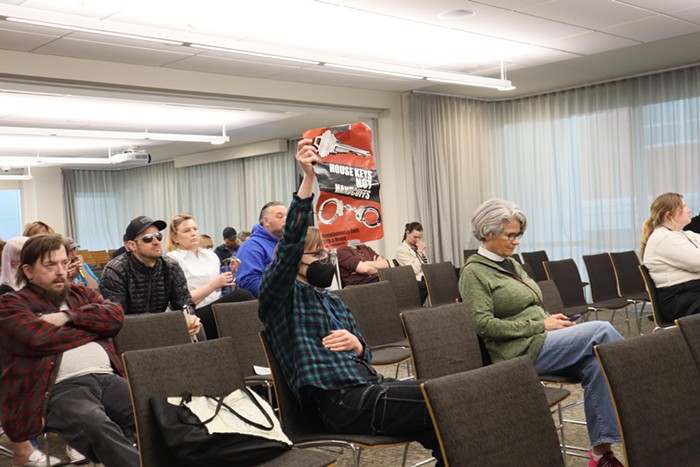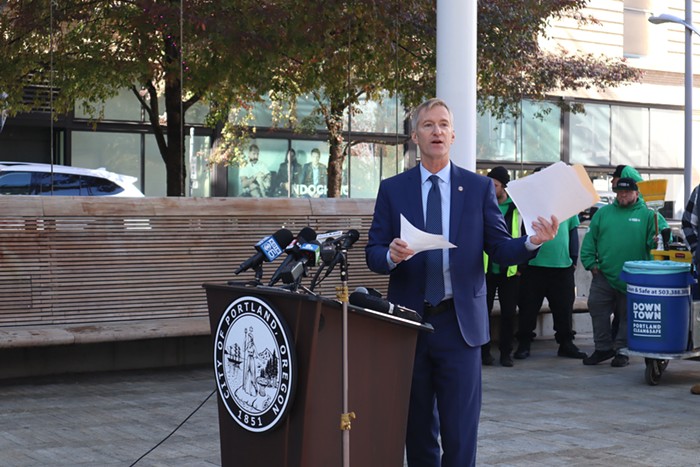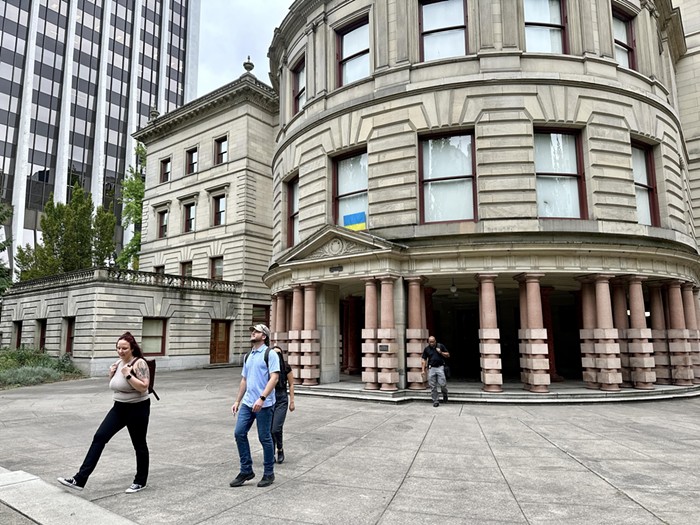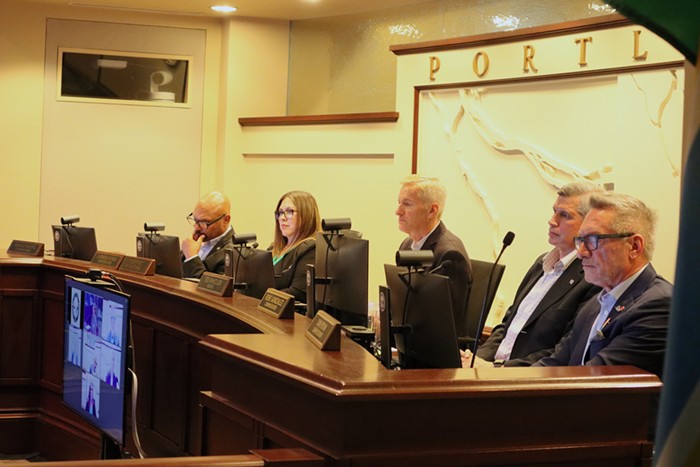The first lawsuit against Portland police officers for their treatment of protesters in 2020 has reached its day in court.
The case comes from Erin Wenzel, a care coordinator at Oregon Health and Science University who attended a racial justice protest with her husband on August 14, 2020. Wenzel, who lives in Beaverton, attended the North Portland protest as a volunteer medic, bringing first aid supplies to help any injured demonstrators. She identified this role by wearing a red cross on her helmet.
As with many of 2020's nightly racial justice protests, officers with the Portland Police Bureau (PPB) moved to disperse the protest shortly after dark, as demonstrators marched south. Wenzel said she was following police instructions to leave when an officer ran at her from behind and slammed her to the ground, breaking her arm and smashing her face onto the concrete. After getting up, Wenzel said she was pushed by a protester and fell into another officer, who struck her in the leg with a baton, causing her to fall to the ground. Wenzel suffered a skinned knee from the second fall.
There are no witnesses that observed these actions, nor is there video taken of them, leaving Wenzel as the sole witness to the alleged crimes.
Wenzel filed a lawsuit against the city of Portland in October 2020 for her assault by PPB officers, requesting $500,000 for physical and emotional damages. Unlike other similar civil lawsuits filed by protesters injured by cops in 2020, Wenzel's case didn't resolve in a settlement agreement with the city, instead heading to trial.
As this trial is the first of its kind to reach a jury, its results will serve as a bellwether for both defense attorneys and city lawyers with similar cases on the horizon. According to Juan Chavez, an attorney with the Oregon Justice Resource Center (OJRC) who is representing several people in lawsuits against PPB’s 2020 actions, lawyers like him are eager to see how Multnomah County jurors rule on a protest-related case.
“Historically speaking, Oregon juries aren’t generous with money or finding liability in protester cases against the police,” Chavez told the Mercury in August.
Wenzel is being represented in court by lawyer John Burgess.
"Evidence will show that my client was dispersing when she was struck from behind and knocked from behind by an officer without warning," said Burgess on Tuesday during the trial's opening arguments. "The officer did not do it by accident."
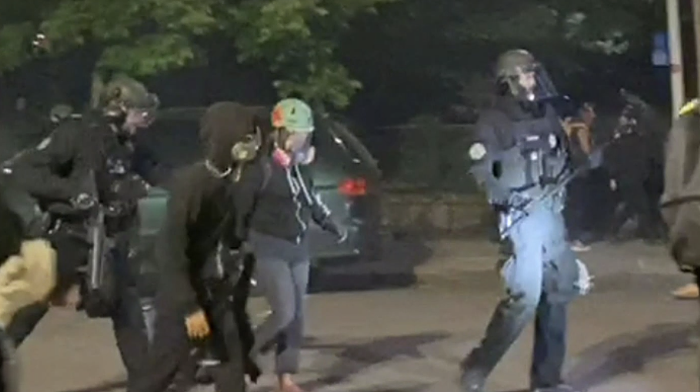
The trial is also the first opportunity to hear from some of the more notorious police officers who frequented 2020 demonstrations and used force against protesters. While the city has been unable to identify which PPB officer was responsible for pushing Wenzel, it has identified officers who were working at the North Portland protest the evening of August 14.
That includes Officer Brent Taylor and Detective Erik Kammerer—two officers who were members of the bureau's now-defunct Rapid Response Team (RRT), the PPB team dedicated to responding to protests in 2020. As the demonstrations wore on through 2020, activists identified both men as officers who frequently used force against members of the public.
City attorneys have relied on their testimony to paint the protest as violent and chaotic, hoping to place Wenzel as a member of the tumultuous crowd.
On Wednesday, Taylor described a tactic called a "dynamic" by police, in which a line of officers run at a group of protesters in hopes of dispersing the crowd. (Protesters have referred to this action as a "bull rush.") Taylor said the reason officers choose to use a dynamic is when police are feeling threatened by protesters—which they felt the evening of August 14.
"[That night,] bottles were being thrown at us, paint balloons were being thrown at us," said Taylor. "Staying in a stagnant position was extremely dangerous for us. One reason we would move people, is that that’s the safest time for officers, because people would not be throwing things at us."
City attorney William Manlove pointed to video that showed Wenzel in the midst of the crowd of protesters, describing her actions as "marching" with demonstrators. He also shared with jurors that Wenzel's husband, Phillip Wenzel, had been arrested for allegedly assaulting a police officer during the August 14 protest.
Wenzel, however, has testified that she threw nothing at police, carried no weapons, and didn't engage in any anti-police chants. Before that night, Wenzel said she didn't carry strong anti-police sentiments.
"I held police in high regard," said Wenzel Tuesday. "To have this happen to me, it was terrifying. Cops are supposed to be there to protect you. And they weren’t."
Wenzel said she was simply attempting to follow officers' orders to get out of the street and leave the area when she was knocked to the ground. Wenzel said she was unable to leave the street and get to the sidewalk at the time, since the sidewalk was crowded with other marchers. After being hit by an officer the second time, Wenzel said she tried to find her car to leave, but was lost in the unfamiliar neighborhood.
"I think it’s at this point that the emotional impact of what had happened to me sunk in," said Wenzel. That's when she sent her GPS coordinates to a friend, who then picked her up. After locating her parked car, Wenzel drove herself to the emergency room.
"Cops are supposed to be there to protect you. And they weren’t."
Because of her broken arm, bruising, and a scraped knee, Wenzel was unable to work for more than two months, and said she required help doing basic tasks around her home. Wenzel was also diagnosed with post-traumatic stress disorder (PTSD) after the incident, and described having extreme nightmares and paranoia after the sun sets.
On Tuesday, city attorneys pressed a psychiatrist who had diagnosed Wenzel to disclose that there were other stressors in Wenzel's life that could have led to her mental health issues. Manlove said Wenzel was likely impacted by the stress of her husband's arrest and the fact that a right-wing writer doxxed her family online after the arrest, creating a safety threat.
Psychologist Suzanne Best testified that it was possible Wenzel could have PTSD without being assaulted by a police officer.
Although the exact officers who injured Wenzel could not be identified, Burgess pressed officers to defend their actions on August 14.
"You agree that, if an individual is not resisting or throwing projectiles or doing anything other than running in the same direction of the police, that it wouldn't be appropriate to shove them from behind onto the ground, correct?" Burgess asked Detective Kammerer Thursday.
"Correct," Kammerer replied.
Burgess then played a video depicting an officer forcibly shoving a protester to the ground the night of August 14. Asked to describe what he saw, Kammerer said that the video showed someone being pushed out of the street and tripping over a curb, causing them to fall to the ground. Kammerer said he did not observe any of the RRT officers he oversaw using force that wasn't in alignment with PPB's policies the night of August 14.
He acknowledged that he himself did apply force "several times" against protesters that evening.
PPB Lieutenant Franz Schoening echoed Kammerer's analysis of the evening. While Schoening was not working August 14, he was responsible for reviewing all force used by RRT officers that evening. Burgess asked if Schoening had any concerns with the level of force he saw take place August 14.
"Use of force is disturbing, but do I have concerns that it violated Portland Police Bureau policy? Not necessarily," said Schoening.
Burgess also asked Schoening, who has be present every day of trial, if there was anything he heard in Wenzel's testimony that made him believe her conduct warranted the level of force she received.
"Based solely on her testimony," Schoening said. "I would say no."
Jurors will hear closing arguments Monday, and are expected to start deliberations later that day.


